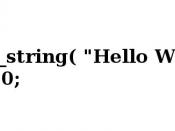The purpose of this document is to provide a summary of "Mobile Code Technology." Mobile code is becoming more essential and at the same time damaging in other ways. Its invention and continued development is embedded in our daily activities and affecting our decision making. The Wikipedia defines mobile code as "software obtained from remote systems, transferred across a network, and then downloaded and executed on a local system without explicit installation or execution by the recipient" (Wikipedia, 2006). In a nut shell, the local execution of remotely sourced codes by any program or process falls under the concept of mobile code technology.
There are several kinds of labels that are used to refer to mobile code technologies. Some of which we know as mobile agents, downloadable code, executable content, active capsules, remote code, and various others. The name mobile agent is perhaps the most popular and impressive of them all.
We all know it to be a software agent that has the ability to travel from one place to another to autonomously perform an assigned task as well as interacting with the hosts and other agents at its destination. Throughout this document we will analyze and define various aspects of this rapidly emerging technology in order to develop a better understanding.
The most common forms and examples of mobile code includes web applets (Java), dynamic email, ActiveX controls, Visual Basic for Applications (VBA), Built-In Objects and Embedded Script (JScript/VBScript). According to authors Tennenhouse D. and Wetherall D. (1996), mobile code are categorized base on the type of codes that are distributed. The four types of code distribution methods are Intermediate Code, Just-in-time compilation, Native Binary Code, and Source Code.
* Intermediate Code: In this approach programs are compiled to platform-independent intermediate code, which is then...


